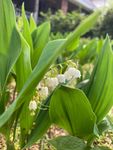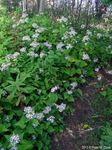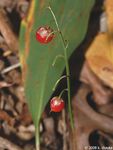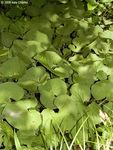INVASIVE PLANTS FACT SHEETS - TORONTO MASTER GARDENER LILY OF THE VALLEY
←
→
Page content transcription
If your browser does not render page correctly, please read the page content below
TORONTO MASTER GARDENER INVASIVE PLANTS FACT SHEETS LILY OF THE VALLEY SUPPORTED BY THE INVASIVE SPECIES CENTRE
WHY IS LILY OF THE VALLEY A
PROBLEM
Photo: Helen
Battersby
Lily of the Valley is invasive in natural areas and
spreads by both seeds and rhizomes and forms
large colonies which out-compete native
species for moisture, sunlight, nutrients and
space.
IDENTIFICATION
Leaves are basal, usually two, oval-ovate with
Photo: Helen Battersby
pointed tips, parallel veins and smooth edges
(entire), held on a single stalk.
LILY OF THE VALLEY
(Convallaria majalis)
WHAT IS LILY OF THE VALLEY
Lily of the Valley is a perennial herbaceous
groundcover plant native to Asia and Europe. It
grows from underground rhizomes that spread
horizontally and often with amazing speed. Lily
of the Valley has broad, green leaves and
delicate, sweet-smelling white flowers that
resemble tiny bells on stalks. They stand about
18 cm tall. It can tolerate full sun to full shade
but prefers partial shade and rich well drained
moist soil. All parts of the plant are highly
poisonous including the red berries. If ingested
the plant can cause abdominal pain, nausea,
vomiting and irregular heartbeats.
Photo: Helen Battersby
TORONTO MASTER GARDENERS SUPPORTED BY
INVASIVE PLANTS FACT SHEETS THE INVASIVE SPECIES CENTREFlowers are a single raceme of six to 16 white, MANAGEMENT FOR THE TORONTO
nodding, bell shaped and pleasantly scented.
GARDENER
Photo: TMG
Do not plant Lily of the Valley. Once
established, it is difficult to remove and must be
removed in its entirety with all the roots before
it sets seed. You may need to do this for several
years before the seed bank in the soil is
depleted. It can be difficult to remove the
rhizomes in their entirety as they break easily
and even a small piece may resprout (this may
be avoided if soil is dug to a dept of 2 feet (60
cm) and screened to remove roots and
rhizomes but this is very labour intensive).
However, with persistent pulling the plants
carbohydrate reserves should eventually be
exhausted. Roots and other reproductive parts
should be disposed of by bagging and putting
in the trash (reproductive parts of invasive
plants should not be included in yard waste).
Photo: TMG
Fruit is a single red to orange red berry.
Another highly effective method is to smother
the plants. If deprived of light the plant will be
unable to photosynthesise and will eventually
die. This may be done with either a weighted
tarpaulin or thick mulch on top of cardboard.
This may take one to two years to be effective.
A final option in areas with full sun is
solarization. Ideally this will take place over four
to six weeks during hot summer months. Cut
the plant to ground level, water the ground
deeply until wet, and cover the area with clear
plastic. Use caution with this method as the
heat can kill or damage other plants including
trees or large shrubs whose roots extend
beneath the area.
If you see Lily of the Valley or other invasive
species in the wild, please contact the Invading
Species Hotline at 1-800-563-7711, or
visit EDDMapS Ontario to report a sighting.
TORONTO MASTER GARDENERS SUPPORTED BY
INVASIVE PLANTS FACT SHEETS THE INVASIVE SPECIES CENTRESIMILAR NATIVE PLANTS AND
ALTERNATIVES
Canada mayflower (Maianthemum
canadense) is sufficiently similar in appearance
to also be known as false Lily of the Valley.
Leaves are somewhat broader and the white
flowers are a terminal cluster.
WILD GINGER
(Asarum canadense)
CANADA MAYFLOWER
(Maianthemum canadense)
There are also many other attractive native
ground covers which can be used as BIG LEAF ASTER
alternatives to Lily of the Valley. These include: (Aster macrophyllus syn. Eurybia macrophylla)
TORONTO MASTER GARDENERS SUPPORTED BY
INVASIVE PLANTS FACT SHEETS THE INVASIVE SPECIES CENTREPhoto: TMG
BUNCHBERRY
(Cornus canadensis)
WOODLAND/WILD
STRAWBERRY
(Fragaria spp.)
V
WOOD ANEMONE Photo: Helen Battersby
(Anemone quinquefolia)
TORONTO MASTER GARDENERS SUPPORTED BY
INVASIVE PLANTS FACT SHEETS THE INVASIVE SPECIES CENTREREFERENCES
Credit Valley Conservation, CVC Priority Invasive Plants, accessed at: https://cvc.ca/wp-
content/uploads/2011/07/11-150-priorityinvasives-11-list-web.pdf
Cymbaly, Lauren, Invasive Alien Plant Species Found in the Carolinian Zone. 2007. Accessed at:
https://caroliniancanada.ca/legacy/Documents/student_assistantship_program/Reports/Invasive
%20Alien%20Species%20Found%20in%20Carolinian%20Zone.pdf
Illinois Wild Flowers, Convallaria majalis, accessed at:
https://www.illinoiswildflowers.info/weeds/plants/lily_valley.htm
Ontario Parks, Invasive Species, accessed at:
https://www.ontarioparks.com/documents/content/10/172
Toronto and Region Conservation Authority, Invasive Plant List, accessed at:
http://www.trca.on.ca/dotAsset/36890.pdf
PHOTO CREDIT
Photos courtesy of :
Peter M. Dziuk and Katy Chayka (Minnesota Wildflowers: https://www.minnesotawildflowers.info)
Helen Battersby and the Toronto Master Gardeners (as marked in individual copyright information)
TORONTO MASTER GARDENERS SUPPORTED BY
INVASIVE PLANTS FACT SHEETS THE INVASIVE SPECIES CENTREYou can also read



























































